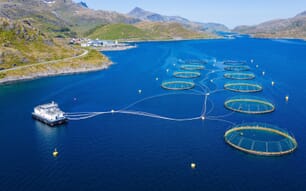More than half of all seafood consumed today is farmed. And, while commercial fishing and wild harvest are and always will be an important part of the seafood supply chain, aquaculture is the fastest growing food production sector in the world and is responsible for nearly all global supply growth since the 1990s. By authorizing NOAA to identify suitable locations for offshore aquaculture and outlining clear standards for environmental review, the President’s Order paves the way for America to join this global trend and realize the vast array of economic benefits that the aquaculture sector already provides in other parts of the world. It also lays important groundwork to help efficiently implement future legislation needed to further support US aquaculture production.

© Mook Farms, Maine
With the global population expected to approach 10 billion by 2050, expanding US aquaculture to supplement wild capture seafood production is vital to meeting the growing demand for high-quality proteins. At present, the US lags far behind the rest of the world in farmed seafood production. The single biggest reason for that is the lack of a clear regulatory pathway for permitting new projects, a challenging reality that has forced many American businesses to invest in other countries. This moment marks the culmination of years of effort by industry leaders, including members of Stronger America Through Seafood, to help address some of the uncertainties that have deterred businesses from instead investing in food production here at home.
Aquaculture is already driving major economic gains and providing supplemental employment for fishermen and others in some coastal and maritime communities. In New England, fishermen hurt by declining stocks and increasing government restrictions on cod and lobster are now looking to aquaculture to grow oysters, mussels, seaweed and fish. Aquaculture in New England now generates nearly $150 million worth of seafood annually. Aquaculture jobs are similarly vital in the Pacific Northwest, where commercial shellfish farming has a long and vibrant history dating back to the mid-1800s. In Washington, the industry employs over 3,000 full time and seasonal workers and generates an estimated $270 million in economic contributions to the state.

© King Kampachi, Mexico
These examples demonstrate aquaculture’s potential to help get Americans back to work and provide much-needed economic relief in rural coastal communities. Such relief is more important now than ever before, as those communities begin to reopen in the wake of the ongoing COVID-19 pandemic. The President’s Executive Order will help facilitate federal support for the development of new aquaculture projects and introduce vital environmental standards to ensure that America’s aquaculture expansion is carried out in a sustainable way. This, however, is just one step. It will also be critical for Congress to pass legislation that provides clear guidance and allocates funding for the aquaculture industry to move forward.
By solidifying a federal regulatory framework through legislative action, Congress can help provide a major boost to our economy and position the US to realise greater gains from aquaculture for the foreseeable future. There is no better time than now to help ensure that Americans continue to have access to the healthiest proteins on the plant by choosing to produce more of our food at home.



